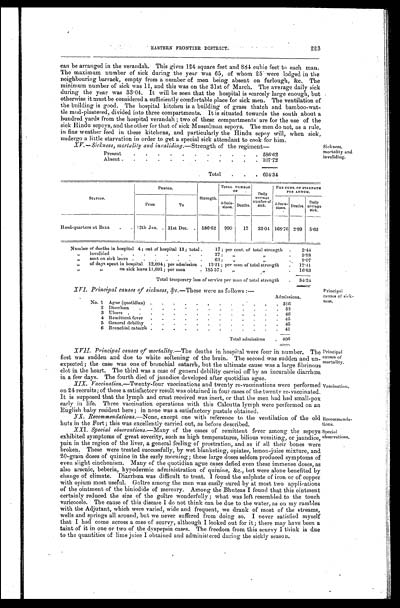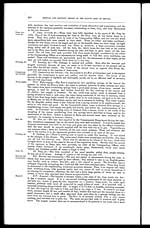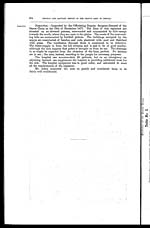Medicine - Institutions > Army health reports and medical documents > Medical and sanitary report of the native army of Bengal > Medical and sanitary report of the native army of Bengal for the year 1876
(253) Page 223
Download files
Individual page:
Thumbnail gallery: Grid view | List view

EASTERN FRONTIER DISTRICT.
223
can be arranged in the verandah. This gives 124 square feet and 884 cubic feet to each man.
The maximum number of sick during the year was 65, of whom 25 were lodged in the
neighbouring barrack, empty from a number of men being absent on furlough, &c. The
minimum number of sick was 11, and this was on the 31st of March. The average daily sick
during the year was 33.04. It will be seen that the hospital is scarcely large enough, but
otherwise it must be considered a sufficiently comfortable place for sick men. The ventilation of
the building is good. The hospital kitchen is a building of grass thatch and bamboo-wat-
tle mud-plastered, divided into three compartments. It is situated towards the south about a
hundred yards from the hospital verandah; two of these compartments are for the use of the
sick Hindu sepoys, and the other for that of sick Mussulman sepoys. The men do not, as a rule,
in fine weather feed in these kitchens, and particularly the Hindu sepoy will, when sick,
undergo a little starvation in order to get a special sick attendant to cook for him.
XV.—Sickness, mortality and inraliding .—Strength of the regiment—
| Present | 586.62 | |
| Absent | 107.72 | |
| Total | 694.34 |
Sickness,
mortality and
invaliding.
| STATION. | PERIOD. | Strength. | TOTAL NUMBER OF |
Daily average number of sick. |
PER CENT. OF STRENGTH PER ANNUM. |
||||
| From. | To. | Admis- sions. |
Deaths. | Admis- sions. |
Deaths. | Daily average sick. |
|||
| Head-quarters at Baxa | 12th Jan | 31st Dec | 586.62 | 990 | 17 | 33.04 | 168.76 | 2.89 | 5.63 |
| Number | of deaths in hospital 4; out of hospital 13; total | 17; | per cent. | of total strength | 2.44 |
| " | invalided | 27; | " | " | 3.88 |
| " | sent on sick leave | 63; | " | " | 9.07 |
| " | of days spent in hospital 12,094; per admission | 12.21; | per man | of total strength | 17.41 |
| " | " on sick leave 11,691; per man | 185.57; | " | " | 16.83 |
| Total temporary loss of service per man of total strength | 34.24 | ||||
XVI. Principal causes of sickness, &c. —These were as follows:—
Principal
causes of
sick-
ness.
| Admissions. | |||
| No. 1 | Ague (quotidian) | 316 | |
| 2 | Diarrhœa | 52 | |
| 3 | Ulcers | 46 | |
| 4 | Remittent fever | 45 | |
| 5 | General debility | 45 | |
| 6 | Bronchial catarrh | 41 | |
| Total admissions | 406 |
XVII. Principal causes of mortality .—The deaths in hospital were four in number. The
first was sudden and due to white softening of the brain. The second was sudden and un-
expected; the case was one of bronchial catarrh, but the ultimate cause was a large fibrinous
clot in the heart. The third was a case of general debility carried off by an incurable diarrhœa,
in a few days. The fourth died of jaundice developed after quotidian ague.
Principal
casses of
mortality.
XIX. Vaccination .—Twenty-four vaccinations and twenty re-vaccinations were performed
on 24 recruits; of these a satisfactory result was obtained in four cases of the twenty re-vaccinated.
It is supposed that the lymph and crust received was inert, or that the men had had small-pox
early in life. Three vaccination operations with this Calcutta lymph were performed on an
English baby resident here; in none was a satisfactory pustule obtained.
Vaccination.
XX. Recommendations .—None, except one with reference to the ventilation of the old
huts in the Fort; this was excellently carried out, as before described.
Recommenda-
tions.
XXI. Special observations .—Many of the cases of remittent fever among the sepoys
exhibited symptoms of great severity, such as high temperatures, bilious vomiting, or jaundice,
pain in the region of the liver, a general feeling of prostration, and as if all their bones were
broken. These were treated successfully, by wet blanketing, opiates, lemon-juice mixture, and
20-grain doses of quinine in the early morning; these large doses seldom produced symptoms of
even slight cinchonism. Many of the quotidian ague cases defied even these immense doses, as
also arsenic, beberia, hypodermic administration of quinine, &c., but were alone benefited by
change of climate. Diarrhœa was difficult to treat. I found the sulphate of iron or of copper
with opium most useful. Goître among the men was easily cured by at most two applications
of the ointment of the biniodide of mercury. Among the Bhuteas I found that this ointment
certainly reduced the size of the goître wonderfully; what was left resembled to the touch
varicocele. The cause of this disease I do not think can be due to the water, as on my rambles
with the Adjutant, which were varied, wide and frequent, we drank of most of the streams,
wells and springs all around, but we never suffered from doing so. I never satisfied myself
that I had come across a case of scurvy, although I looked out for it; there may have been a
taint of it in one or two of the dyspepsia cases. The freedom from this scurvy I think is due
to the quantities of lime juice I obtained and administered during the sickly season.
Special
observations.
Set display mode to: Large image | Zoom image | Transcription
Images and transcriptions on this page, including medium image downloads, may be used under the Creative Commons Attribution 4.0 International Licence unless otherwise stated. ![]()
| Permanent URL | https://digital.nls.uk/74998788 |
|---|




